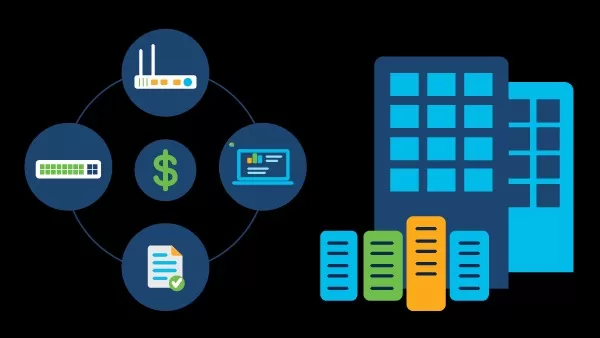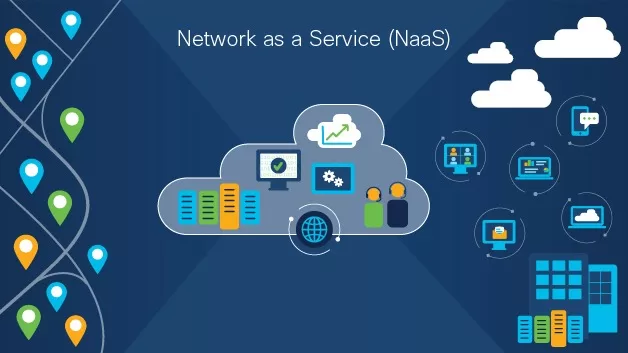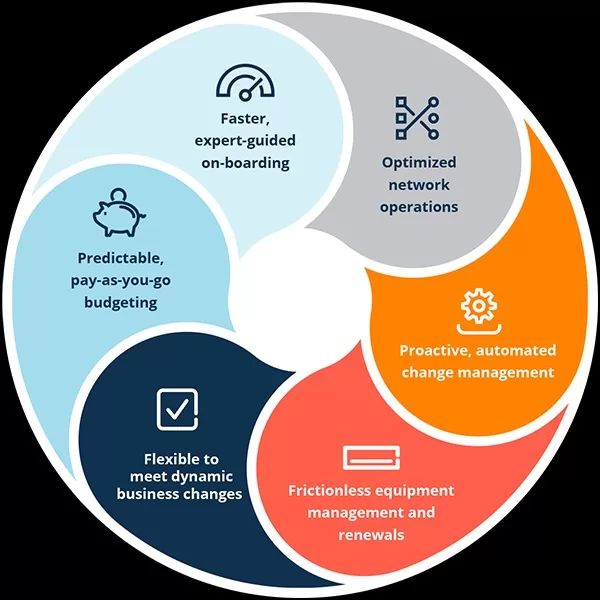Networking-as-a-Service (NaaS) is a service model that enables businesses to access network resources, including virtual routers, switches, firewalls, load balancers, and other networking components, on demand through the cloud. In brief, NaaS is a method to delegate the administration and implementation of network infrastructure. This enables enterprises to prioritize their core strengths instead of allocating resources toward the upkeep and modernization of their networking infrastructure.

NaaS also aids organizations in acquiring networking capabilities without the need to invest in tangible equipment and, instead, compensate for the services utilized through a subscription model. When comparing NaaS to the construction of internal networking infrastructure, there are a number of advantages that NaaS provides.
- Scalability: NaaS has the ability to be adjusted accordingly to accommodate fluctuating business requirements. This is particularly advantageous for enterprises that encounter periodic variations in footfall or that are swiftly expanding.
- Flexibility: NaaS provides organizations with the ability to deploy and manage their networks remotely, without any limitations on location or time. This is suitable for enterprises with dispersed workforces or with branches in various areas.
- Cost-effectiveness: NaaS can aid businesses in reducing expenses on IT costs by eliminating the necessity to acquire and sustain costly networking hardware. Moreover, NaaS providers often present flexible payment options, allowing businesses to effectively handle their financial resources.
- Enhanced simplicity: NaaS aids enterprises in streamlining their network operations and minimizing reliance on specialized IT knowledge. Service providers often provide a portal for businesses to autonomously manage their networks and implement necessary modifications.

NaaS is gaining popularity in the industry
The market for NaaS services is projected to experience substantial growth in the upcoming years. Gartner predicts that the worldwide NaaS market will achieve a significant value of $45 billion by the year 2025. This expansion is being propelled by various elements, such as the rising acceptance of cloud computing, the escalating desire for remote work, and the necessity for businesses to enhance their flexibility and adaptability.
NaaS is associated with the ITOps meta trend
NaaS is among various developments that are revolutionizing the realm of IT Operations (ITOps). ITOps encompasses a range of tasks and procedures related to the oversight and upkeep of an enterprise’s IT framework, encompassing elements such as hardware, software, networks, and applications.
One of the main objectives of ITOps is to enhance the efficiency and effectiveness of IT operations. Achieving this can be done using different methods, including automation, cloud computing, and DevOps.
NaaS plays a significant role in ITOps by streamlining the management and deployment of network infrastructure. This allows IT personnel to dedicate their attention to additional responsibilities, such as the creation and administration of applications.

NaaS is assisting businesses in cost savings
One of the main advantages of NaaS is its potential to assist businesses in reducing their IT expenses. This is because NaaS providers generally provide pricing based on usage, enabling businesses to solely pay for the services they utilize.
Furthermore, NaaS has the potential to assist enterprises in minimizing the necessity for costly networking equipment investments. Providers of Network-as-a-Service (NaaS) usually possess an extensive collection of communal assets that they can assign to enterprises as needed. This can assist businesses in evading the initial expenses of procuring and upkeeping their personal networking equipment.
NaaS is aiding enterprises in enhancing their adaptability and ability to respond to alterations
One additional advantage of NaaS is its ability to assist businesses in enhancing their flexibility and adaptability to alterations. This is due to the fact that NaaS providers have the ability to efficiently and expeditiously implement novel network services and applications.
This can be particularly advantageous for enterprises that require prompt adaptability to market dynamics or customer demands.
NaaS is potentially contributing to the expansion of employment prospects
The expansion of NaaS is also generating fresh employment prospects for IT experts. NaaS providers require the services of proficient IT experts to create, implement, and oversee their networks. Moreover, enterprises embracing NaaS must recruit IT experts to oversee their NaaS subscriptions and seamlessly incorporate NaaS offerings into their current IT framework.

Conclusion
NaaS is an increasingly expanding market that is revolutionizing the manner in which enterprises acquire and oversee their network assets. NaaS provides various advantages, such as the ability to scale, adaptability, cost efficiency, simplified processes, and enhanced responsiveness. Considering that the market for these services is forecasted to grow 8x in the next six years.
As the adoption of NaaS becomes increasingly prevalent, it is anticipated that a growing number of businesses will embrace this service model. Furthermore, it is highly likely that novel and groundbreaking NaaS offerings will surface in the forthcoming years.
Here are some general examples of how organizations are utilizing NaaS:
- A business entity with numerous retail locations is utilizing NaaS as a means to establish connectivity between its stores and its central network. This enables the chain to efficiently and swiftly implement new applications and services across its stores.
- A company is utilizing an undisclosed service to establish a protected network for its employees who work remotely. This enables the organization’s staff to conveniently access its resources from any location globally.















